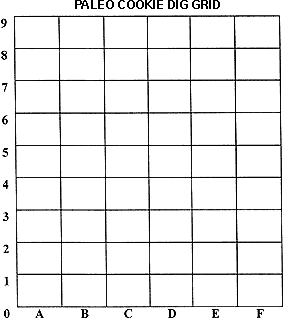PALEO COOKIE DIGSHARON K. HEINDELINTRODUCTIONGrade Level: 1-3Time: Approximately one hour. Purpose: Students are introduced to the concept of a dig site and the use of simple grids. Skills: The science and mathematics process skills used include: observation, classification, simple grids and bar graphs. — At the Mammoth Site we use the bone bed and our Junior Paleontologist dig as a visual for the students. For teachers too far away to visit the Mammoth Site, a mock dig could be set up in any size box using chicken bones or plastic bones for fossils, plastic spoons and small paint brushes for tools. Overview: Students examine a variety of soil samples and then conduct a simulated "dig" in a grid of no-bake cookie bars.
MATERIALSA variety of soil samples, such as potting soil, sandy soil, soil with more pebbles or clay. Samples may be collected from various places on the school grounds or from students' yards. Paper plates to hold soil samples and cookie bars for each student. Toothpicks for each student to "dig" in soil and cookie bars. Large pan of no-bake cookie bars, such as Rice Krispie bars, with up to four non-melting ingredients such as raisins, macaroni, lima beans, peanuts, or sunflower seeds still in the shell. The idea is to provide a chunky cookie bar with obvious parts. Students may bring ingredients from home and make the pan of cookie bars during class as practice in measurement skills. Sticky notes. Small squares or circles of different colors, one type for each non-melting ingredient in the cookie bars. Optional poster board grid (laminated for re-use) for constructing bar graphs and dry erase markers for labeling the grid. Alternatively a grid can be drawn on the chalk board.
PROCEDURES
Preparation: Students bring ingredients for cookie bars from home and small bags of soil from their yards.
|
 Paleo Cookie Dig:
Paleo Cookie Dig: